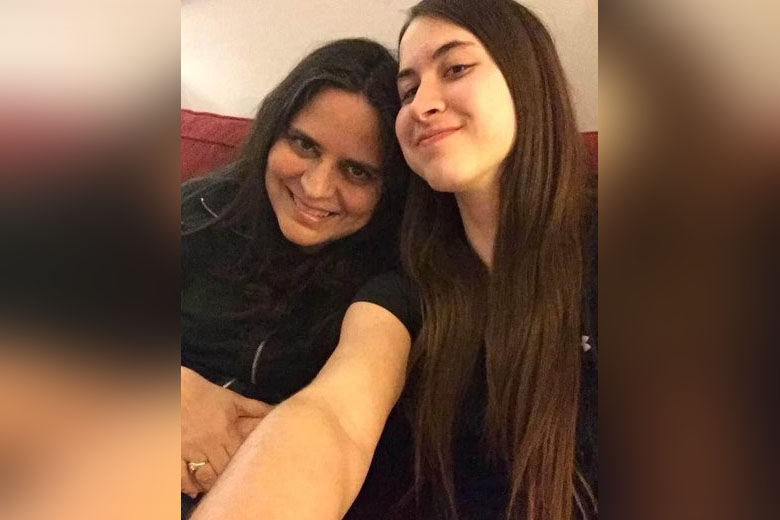This article is part of the WTOP series, “Facing Down Fentanyl: Teens Confront Drug Danger.”

To say Colette Russ was a busy high-schooler would be an understatement. If you didn’t see her playing on the basketball court at Winston Churchill High School in Potomac, Maryland, she was making music in the school’s orchestra or honing her guitar skills at home.
“She had a passion for music,” said Colette’s mom, Elena Suarez, of Bethesda.
She consistently made the honor roll at her school, and from a young age had a soft spot for the downtrodden. She would spend hours outside of school helping the homeless, working with special needs children and working with animal rescues, Suarez recalled.
“She just had a zest for life,” Suarez said. “She was very charismatic. She was very funny. She was always making everyone around her laugh.”
But in her sophomore year of high school, Suarez said her daughter suffered a trauma that drove her to drug use.
In just over two years, Colette overdosed four times. The first three times, people around her had Narcan, an opioid overdose reversal drug, which they used to revive her. The last time, in August of 2020, when Colette was 19, she was alone in a hotel room. She died from an overdose of drugs laced with fentanyl.
A growing problem
According to the U.S. Centers for Disease Control and Prevention, more than 70,000 people died from overdoses involving synthetic opioids, primarily fentanyl, in 2021 — the most recent data available. Data covering deaths specifically from fentanyl for young people ages 15-24 isn’t available, but a total of 7,426 Americans in that age group died of drug overdoses that year, according to the CDC.
Read more from the series “Facing Down Fentanyl: Teens Confront Drug Danger”
- Unseen and unheard: Unique Maryland high school aims to help students beat addiction
- The small blue pills behind a surge in children’s fentanyl-related hospital visits in the DC area
- Md. school system races to battle fentanyl epidemic facing teens
According to preliminary numbers from Maryland’s Opioid Operational Command Center, 131 people under 25 died from overdoses in 2021, the most recent year for which complete data is available.
More than 80% of all overdose deaths in the state in the last few years involved fentanyl, according to the Maryland data.
In Maryland and throughout the D.C. region, there has been rising concern about youth overdoses involving fentanyl, prompting schools to begin to stock Narcan, among other steps.
In a report in February for the Montgomery County Council, officials said fentanyl use and overdoses among young people “has become a growing problem” in the last two years.
Data from the police department showed youth overdoses — those involving people 21 and under — “spiked in 2022, rising 77%,” according to the report. “There were 48 youth overdoses last year, 11 of which were fatal.” That compares to 27 youth overdoses in 2021, five of which were fatal.
‘The signs were all there’

Suarez said her daughter’s spiral into addiction began after Colette returned from a 2017 trip to Brazil with some friends and a mother Suarez knew. When her daughter returned, she was a different person, Suarez recalled. She was sad, moody and aggressive.
What Suarez didn’t realize at the time was her daughter had been sexually assaulted while on that trip, and she believes the trauma of what happened led Colette to drug use.
According to a National Institutes of Health study, adolescents with substance use disorders were three times more likely to report they suffered a traumatic event. The study found the top two traumatic events reported included violence and sexual abuse.
Suarez said her daughter at first didn’t reveal what happened to her on the trip, and she was similarly left in the dark about her drug use, which she believes her daughter used as a way to cope with what happened to her.
But looking back, Suarez said the signs were there. In addition to changes in Colette’s mood, she also began hanging out with a new group of friends — and her grades started to slide.
“The signs were all there, from being almost a straight A’s, very few B’s students. She barely made it the senior year,” Suarez said.
The behavioral changes Suarez noted in her daughter are common in teens who are struggling with addiction. Experts say other symptoms are depression, as well as changes in eating and sleeping patterns.
Seeking help
Suarez said once she learned about the assault, she started getting her daughter professional help. But she said she was slow to realize how dire her daughter’s drug use had become.
She said she later learned her daughter first started using drugs when someone offered them to her. “He offered her crack. And the addiction came on strong and fast,” she said.
She added, “It’s took me quite a while to accept or realize that my daughter was using substances, because as parents we are in denial. The typical response is, ‘not my child,’” said Suarez.
Suarez said for the last year and a half of her daughter’s life, she desperately sought out treatment. She had her daughter hospitalized and watched her go in and out of treatment programs eight times.
“Every single time, in every single treatment program, she ran away,” Suarez said.
Suarez said her daughter was not always open to treatment, and she had her involuntarily treated. At the time, they were living in Florida.
“I put my daughter in front of a judge in Florida eight different times, as she could choose between going to treatment, or potentially — eventually — going to jail. Guess what she picked? She picked going to treatment,” Suarez said.
‘Turn your pain into purpose’
Sadly, in Suarez’s case, her daughter would lose her life to her addiction. Suarez said despite her family’s story, she hopes to help save the lives of other young people — and honor her daughter’s life through sharing her story.
“Every day, she’s my guiding light, my precious Colette,” Suarez said.
She joined an organization called S.O.U.L, which stands for Surviving Out Ultimate Loss. It’s a group of mothers who through their grief go to schools throughout Montgomery County to spread awareness and help parents, friends and even teachers and counselors to spot addiction in children early so they can get the child the help they need.
The road to recovery is difficult not only for the person using a substance, but also for those that care about them. Despite how hard things can get, Suarez urges families to never give up on their loved ones.
She also urges parents to take the time and talk to their children about the dangers of drugs, and more drugs acquired in illegal ways being laced with fentanyl.
“One pill can kill you,” Suarez said.








